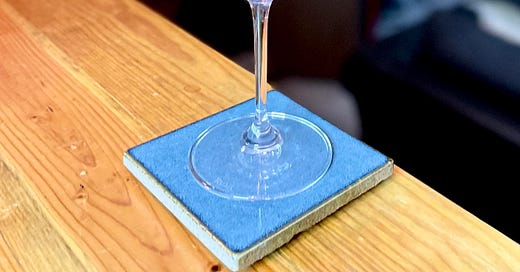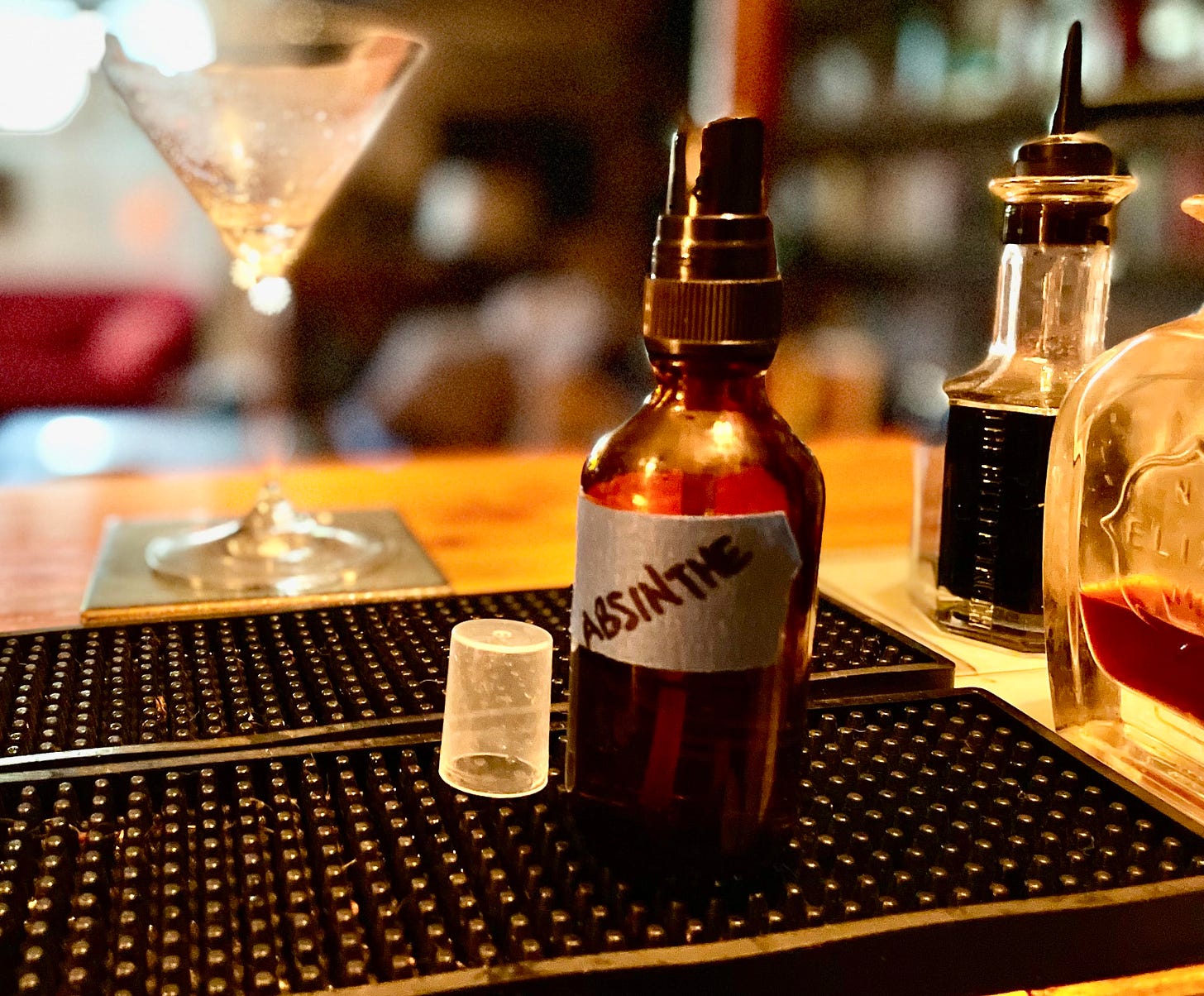The Arsenic & Old Lace, a Martini With Crème de Violette
These crème de violette delights have crème de violette ends.
In recent editions of this newsletter, we’ve looked at the Aviation, a gin sour with a hint of crème de violette, and a Banana Martini, which I dubbed the Curious George. Today’s drink will (kinda, sorta) combine the two.
When I wrote up the Aviation, I noted that crème de violette wasn’t a widely used bottle. But that doesn’t mean there aren’t any other good uses for it at all. It’s close to a one-hit wonder — but not quite.
For example, in last week’s newsletter on the Banana Martini (or Curious George), I argued that you could use it as a template for making fruited Martinis of many types, from grapefruit to pineapple, and so on and so forth, as long as you were using high-quality fruit liqueur.
Some specific fruit liqueurs might require a little bit of adjustment, say by slotting some blanc vermouth into the mix to keep it sweet enough, but in general, the basic idea was the same: Start with an ordinary 2:1 Martini, then remove ¼ ounce of dry vermouth and replace it with ¼ ounce of fruit liqueur. You’ll end up with a highly approachable Martini that is slightly sweet and subtly but distinctly fruit flavored.
Technically, the bottle of crème de violette you used to make your Aviation isn’t a fruit liqueur; it’s flower-flavored. But the same principle applies. Crème de violette acts as a flavored sweetener, and a small amount will give an otherwise conventional drink a slightly updated character. So while it’s true that crème de violette is something you keep around mostly to make aviations, you can also use it in this Martini format.
And if you did, you wouldn’t be the first one to do so.
As it turns out, this comes very close to producing a cocktail that has been around for quite a long time: the Arsenic & Old Lace, which is also known as the Attention or the Atty.
Like the Aviation, the drink appears in Hugo Ensslin’s 1917 Recipes for Mixed Drinks, where it’s called the Attention. I’ve never found a clear account for the drink’s different names, but Adrienne Stillman’s excellent Spirited says the Arsenic & Old Lace moniker came from the 1944 Cary Grant movie. So presumably the Arsenic & Old Lace moniker came later.
In Ensslin’s pre-Prohibition format, it was a four-equal-parts drink with gin, vermouth, crème de violette, and absinthe. Since then, the structure has been reworked to make it more distinctly Martini-like — and, I think, better.
As with so many Martinis, you can find many different specs online. But in general, modern versions tend to resemble the Tuxedo No. 2, another Martini variation with a liqueur and absinthe, an ingredient that is often applied from a mist bottle as a light spray onto the cocktail glass.
Many recipes for the Arsenic & Old Lace/Attention call for a full quarter ounce of absinthe to be incorporated into the drink. You can certainly try that, but I think that’s too much. So instead, we’ll borrow a preparation technique from the Tuxedo No. 2 and use a mist of absinthe sprayed on the inside of the glass. This delivers a pleasant nose of absinthe, but it doesn’t overwhelm the drink.
(You can buy small mist bottles on Amazon. If you don’t have one, you can drop a half barspoon of absinthe into the glass, then turn the glass on its side and rotate it several times in order to coat the interior walls. The goal is to rinse the inside of a cocktail glass with a thin layer of absinthe.)
Like the Curious George, the Perfect Martini, and the Tuxedo No. 2, this is a cocktail that reads as distinctly Martini-like, but a little more mellow and friendly thanks to the added sweetness. And thanks to the crème de violette, it pours light purple and has spring-ready floral character; it’s a great drink to sip outside on a balmy evening, as flowers bloom.
Arsenic & Old Lace/Attention
Mist of absinthe
¼ ounce crème de violette
¾ ounce dry vermouth (Dolin)
2 ounces dry gin (Ford’s)
INSTRUCTIONS
Use a misting bottle to coat the inside of a coupe or Nick and Nora glass with a rinse of absinthe.
Combine all remaining ingredients in a mixing glass.
Add ice, then stir until thoroughly chilled.
Strain into absinthe-misted glass.
Garnish with a strip of lemon peel.
I like to note the structural and historical connections between various drinks and types of drinks, and also to work toward broadly generalizable theories of how to use specific ingredients.
One virtue of this drink is that is does all those things. Another is that it’s satisfying and delicious. It’s nice when everything comes together.
***
(This newsletter relies on Amazon Affiliate linked, via which I may earn a commission.)





Is there a definitive bottle of absinthe? The D&C book usually calls for Vieux Pontarlier, but I can't seem to find a bottle of it. Pernod is readily available, but I'm not sure that they are interchangeable bottles.
This is a great drink. Nicely balanced - if a little sweet for me, and of course the color is just beautiful. This is what the phony(?) pictures of the Aviation look like. I think I like the flavor of the Aviation better, but when my garden is in full flower in a couple of months, I'll drink one of these when conducting a tour.